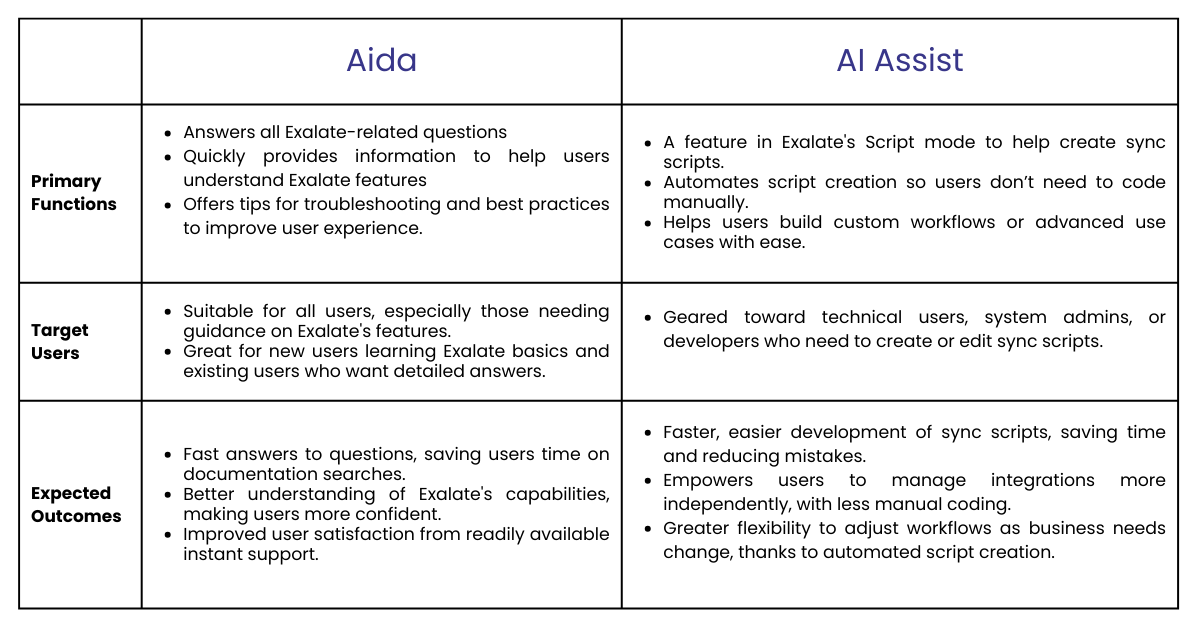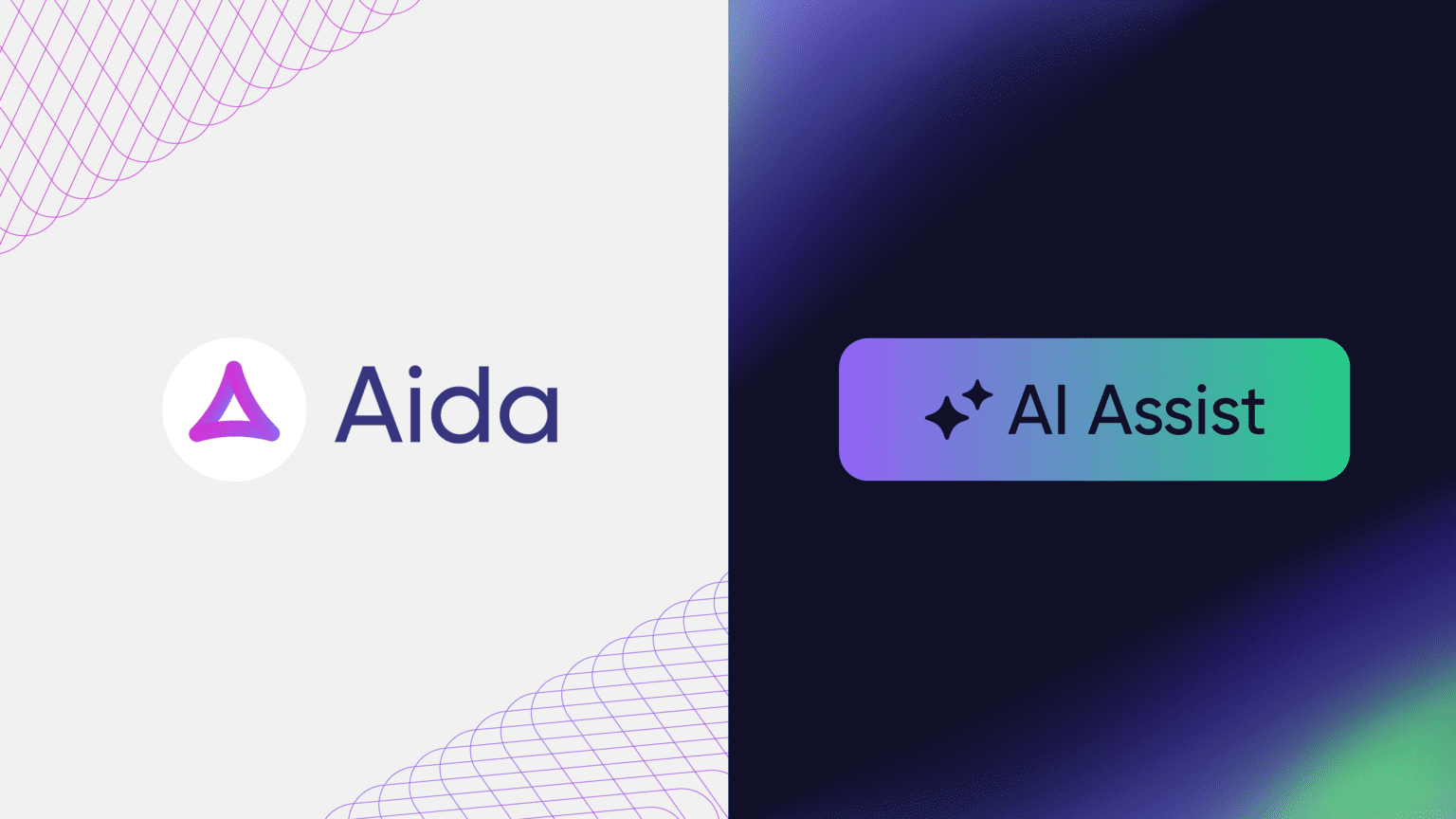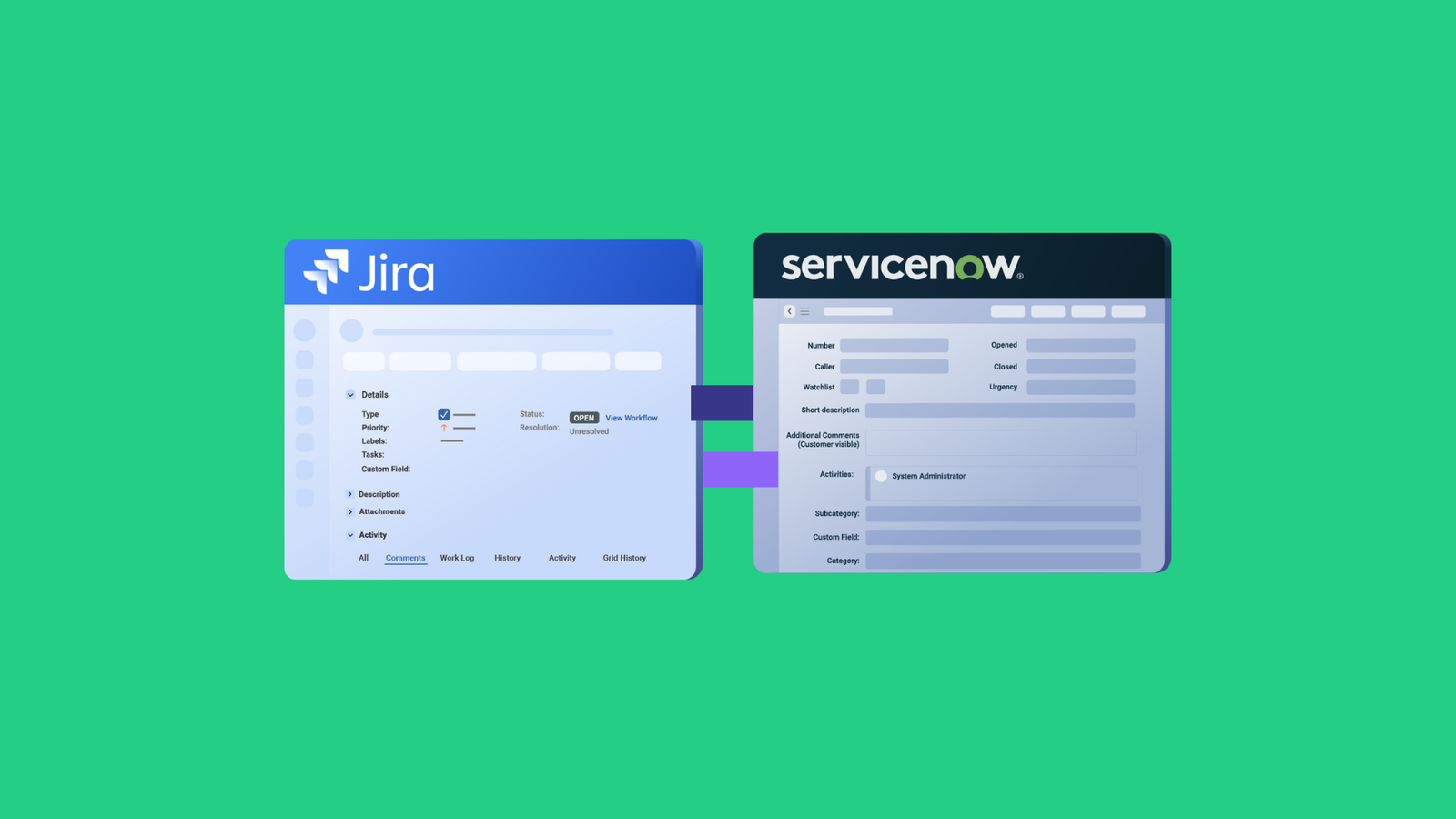At Exalate, the path to use AI in integrations has been anything but traditional. While many view AI simply as a trend, we see it as a medium to break down complex integrations, making them more accessible and efficient.
While bringing multiple AI capabilities to you, we developed two distinct tools: Aida, a virtual guide, and AI Assist, an advanced scripting co-pilot for crafting and refining sync rules. AI Assist was born out of the need to make the process of setting up complex integration use cases easier, especially true for script-based solutions like Exalate.
Each has its own strengths and offers support at different stages of your integration journey.
To help you make the most of these AI capabilities, we highlight their key differences, unique features, and real-world examples to guide you in using them effectively.
Meet Aida: Your Friendly Exalate Sidekick
Aida is an AI-enabled documentation assistant, that improves searchability, making it quicker and easier to get answers to your questions.
She’s like your personal sidekick, ready to help you with everything you want to know about Exalate.
She has a vast knowledge of the Exalate documentation, features, services, and integration possibilities.
How does Aida work?
You can find Aida here.
Just type your questions into the text box, and Aida will display the answer. She’ll provide you with all the relevant information along with the correct documentation links for further reference.
You can also select specific platforms to give Aida more context, and she’ll factor them in to provide a more platform-specific answer.
She’s currently integrated within the Exalate documentation and the community site and is accessible whenever you need her.
Use Cases Where Aida Shines
Aida steps in when you need quick insights or guidance about Exalate’s core functions.
For instance, if you are an admin new to Exalate and want to learn more about installing it on Jira, Aida will break down the steps for you.
Or let’s say you have already created a connection but want to know more about setting up Sync rules using the Exalate admin console – Aida can guide you through it.
Example Scenarios for Aida
- Getting Started with Exalate
Say you want a basic getting started guide to integrate Jira and Azure DevOps using Exalate. Aida will provide you with step-by-step instructions, taking the guesswork out of the initial setup. - Exploring the Features or Capabilities
Maybe you’re wondering, “Can Exalate sync comments and attachments between Jira and Zendesk?”. Aida will answer directly, providing you with the relevant doc pages, and reducing the overall time you spend on the doc site.
AI Assist: An Expert Co-pilot to Craft Sync Rules with Precision
While Aida will provide you with everything you want to know about Exalate, AI Assist takes things a step further, by helping you implement what you have scoped together with Aida.
Designed for users of all skill levels or technical proficiencies, AI Assist helps create dynamic sync scripts for simple or complex integration use cases.
It’s built upon Exalate’s powerful scripting engine to suggest sync rules and optimizations, based on user prompts.
How does AI Assist Work?
AI Assist is available for all Script mode users for free and is embedded within the Exalate console.
Within the sync rules section, you’ll now see a text box, where you enter your sync requirements. Be as precise as possible.
After you’re done prompting, AI Assist will take a look at your existing configuration and sync rules and suggest scripts based on the Exalate API.
You can choose to insert or discard the AI-suggested changes. Refine the prompt if required before publishing your changes.
You can learn more about configuring Exalate Script mode connections with AI Assist here.
Note: We also recommend going through the AI Assist prompting guidelines to get a clearer picture.
Use Cases: Where AI Assist Makes a Difference
Imagine a developer struggling to map and sync custom fields accurately between Jira and ServiceNow.
Just prompt AI Assist the custom field mappings you want to achieve between Jira and ServiceNow in natural language. Specify any additional requirements and hit enter.
AI Assist reviews your existing scripts, suggests new scripts to add, and offers specific adjustments or corrections, thus cutting down trial-and-error time.
Key Differences: Aida vs. AI Assist
While both Aida and AI Assist make Exalate more user-friendly, they serve very different purposes:
– Aida is a conversational AI assistant for onboarding and general Exalate-specific queries. It’s there to simplify the learning curve and provide immediate answers.
– AI Assist is a scripting co-pilot, designed for users who want to craft precise and dynamic sync rules, without the hassle of coding them from scratch.

Aida and AI Assist: The Perfect Pair for All Your Integration Needs
Together, Aida and AI Assist cover the full spectrum of user’s integration needs.
So, you have your integration requirements in hand. You scope them out with Aida and move from this scope to a fully functional sync with AI Assist.
From learning Exalate’s basic features with Aida’s help to generating and fine-tuning complex sync rules with AI Assist, these tools provide a cohesive AI-powered experience that supports users at every stage.
Exalate’s AI tools keep everything related to integrations both accessible and effective, empowering users to achieve seamless cross-company integration with ease.
Note: You can learn more about the data privacy and security policies related to our AI tools here.
However, keep in mind that, like any AI technology, Aida and AI Assist can occasionally make mistakes or misinterpret prompts. Staying vigilant, crafting clear prompts, and carefully reviewing results will help ensure that the AI works effectively.
Recommended Reading:



